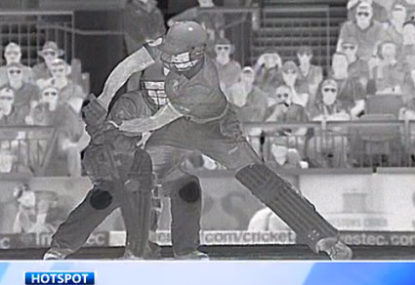How do we solve a problem like the DRS? The current Ashes series has been marred by controversy, and there can be no doubt that it’s overshadowed some engrossing cricket during the first three Tests.
It can never be good for any game to be held up to constant ridicule in the way this marquee series has.
But is the problem with the technology, the implementation, or the public perception of what it’s there for?
As far as the technology goes, it’s currently all over the place.
The Hot Spot has proven fallible after the inventor admitted it may not pick up fine edges under every circumstance.
This was merely one of the ways the infamous Usman Khawaja dismissal should have been overturned, but third umpire Kumar Eyesarepaintedon was happy to remain unconvinced when nothing showed up on his bat.
Hawkeye tracks the ball out of the bowlers hand and offers a predicted line to the stumps if the ball is interrupted by the batsman’s pad. Barely an innings passes without throwing up a prediction that players or fans simply can’t believe.
The Snickometer is available to fans, but not the umpire, adding another layer of frustration to a process that has already lost the faith of many.
The implementation of DRS is unwieldy at best and fatally flawed at worst. Two referrals per team per innings is the current standard.
If used unwisely or selfishly while at the crease, as Shane Watson seems to have the patent on, it can cost a fellow batsman dearly further down the track.
If a team challenges a not out LBW shout while in the field, they can be in the position of being right, yet still lose a referral if not enough of the ball is deemed to be hitting the stumps.
We’ve seen Stuart Broad be the beneficiary of burnt Australian reviews, but is the game really better off with such a grievous umpire error unable to be overturned when it could have been before the bowler was back at the top of his mark?
Many have proposed taking the reviews out of the players hands, and into the complete control of the on-field umpires, which would no doubt create its own set of problems.
We already see too many wickets sent upstairs to be checked for a no-ball. The natural progression is that umpires, fearful of being made to look stupid, would look to refer any call with even a hint of doubt.
Can a happy medium be reached, whereby a Broad howler can be overturned even if a side has run out of challenges?
Should decisions of not out be unreviewable, with only the batting side having the power of calling a review?
Of course, in any sport, the bigger the public outcry, the more media coverage follows, and the larger the controversy, so what part do fans play in all of this?
Many seem to have a problem with the “umpire’s call” facet of Hawkeye. Personally, it’s one of my favourite aspects of the system.
Firstly, Hawkeye is only a predictor, so the fact is its outcomes aren’t set in stone. There has to be a margin for error built in. The standing umpire is duty bound to give the benefit of the doubt to the batsman, but once he’s made his decision, the DRS transfers that benefit of the doubt to the ump.
It’s quite a simple and worthy concept.
The other thing worth remembering about the “umpire’s call” is contained within the name itself. If there was no DRS, the decision would be the same so, at worst, it provides an outcome that is no different to those delivered in over 100 years of the sport.
The main problem with DRS, and indeed with all video review technology in sport, be it cricket, any of the football codes, horse racing, or whatever, is that people expect a clear and decisive, black and white outcome every time.
And while sometimes we do get a clear, unarguable result, with a thick edge onto a pad or a ball that’s cannoned into a goal post, more often we’re left with fifty shades of grey, except of the frustrating non-erotic kind.
Once school of thought suggests that when a review is handed over to the third umpire, the decision should be made from scratch, rather than looking to support the standing call. This would be based on a combination of evidence and balance of probabilities, even allowing for simply what “feels” right.
Would cricket fans be happy with this? Or would supporters feel victimised and rage against this too, if decisions didn’t go their way?
When discussing DRS, it seems there isn’t so much no right or wrong answer, but multiple right and wrong answers each time. Perhaps the BCCI are more astute than backwards, and the umpire’s decision should be good enough for all, as it always has been.
But when it comes to video review technology in sport, the toothpaste is out of the tube, and it isn’t going back. Simply put, you can’t unscramble an egg. All you can do is hope the taste is to your satisfaction.





























































































